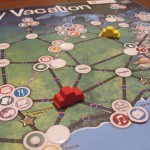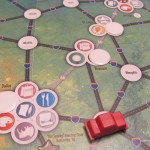 I love road trips and dream about taking my family on a cross-country drive to see the sites—from Mount Rushmore to the largest ball of twine. Of course that also means enduring such travails as flat tires and emergency bathroom stops, but that’s what you get with the freedom of the road! And it’s just this sort of experience that publisher Jolly Roger Games and designer Philip duBarry are trying to recreate with their new Kickstarter game project, Family Vacation.
I love road trips and dream about taking my family on a cross-country drive to see the sites—from Mount Rushmore to the largest ball of twine. Of course that also means enduring such travails as flat tires and emergency bathroom stops, but that’s what you get with the freedom of the road! And it’s just this sort of experience that publisher Jolly Roger Games and designer Philip duBarry are trying to recreate with their new Kickstarter game project, Family Vacation.
Broadly speaking, Family Vacation is a roll-and-move styled game without the roll-and-move. That is, playing it (Philip sent me a pre-production, hand-assembled copy), I definitely got the feel of a traditional, family board game but, mercifully, one that leaves out the spinner.
How it Plays
The real goal of the game is to return home with the happiest family. Starting at different hometowns, players move their cars around the board one space of their choosing each turn. Riding in the car (figuratively) are four family members. Each has been assigned different interests at the start of the game—examples include history, entertainment, nature, and shopping. So while moving their cars around the board, it behooves players to visit spaces that match the interests of their family members, which increases their happiness. Time spent on-the-road, in contrast, is boring to everyone, and thus reduces their happiness.
Also, each of these interest spaces (typically located in the larger cities) can only be visited once. I guess the idea is to have a unique vacation. The first time a space is visited—whether it be a golf course, beach, casino, amusement park, or any of the other family interests—it’s covered with a chip and can no longer contribute to a future visitor’s happiness.
Big cities and boring roads, though, aren’t the only places to visit in this game. When entering smaller towns and local attractions, players draw Adventure Cards, which can represent an event, like the kids fighting in the back seat, or a change in plans, like bonus points for visiting the Boll Weevil Monument.
Many cities have photo spaces. These represent great places for taking pictures. But a small album isn’t worth much for showing friends and family back home. Photos add bonus points to a player’s total family happiness. And that bonus gets much larger the more photos collected.
Another major bonus to a player’s total happiness score comes from visiting three special attractions (e.g., the French Quarter, Statue of Liberty, and Golden Gate Bridge) some time during the game. These special attraction goals are assigned individually to players before play begins. And in fact, the game can’t end until at least one player has visited at least one of their attractions.
The game ends with a countdown clock triggered when the first player who’s collected an attraction bonus returns to his hometown. At the end, everyone totals the individual happiness scores of their family members and adds any earned bonuses. The one with the highest total happiness is the winner.
What I Think
Altogether, Family Vacation works very well. Winning the game involves a fair amount luck—via Adventure Cards, family interests, hometown assignments, and attraction bonuses—but also depends on some strategic planning—what route to take, which sites to see, and when to go home.
Now with that kind of assessment, I expect the hobby gamers among you to be thinking of Family Vacation as a potential gateway game—that is, the kind of game that helps hook friends and family on games with elegant mechanics and strong decision points. Unfortunately, to that I would have to say no. While Family Vacation is one that I would be comfortable playing as a strategy gamer, as I stated earlier, it very much feels like a traditional family board game. I don’t think the strategy elements, as good as they are, take it beyond that.
Still, Family Vacation could be a great game to play at family gatherings or for kids to play with the grandparents. I think the vacation theme will have broad appeal. And I look forward to seeing it funded on Kickstarter.
Trending
- Massdrop.com
- Oh the Irony—Illuminati Card Game Continues to Inspire Conspiracy Theorists
- Footprints, an Educational Ecology Game
- Home
- USPS Adds Board Game Flat Rate Box
- Baila, the Estonian Drinking Card Game
- Crystal Caste Wins Dice Patent Suit Against Hasbro
- Mirror Game, Red and Blue
- Are Board Games Dangerous?
- Board Games Based on Hindu Mythology
Archives
Most Popular Articles
- Oh the Irony—Illuminati Card Game Continues to Inspire Conspiracy Theorists
- The 20 Most Valuable Vintage Board Games
- The Truth About Dominoes On Sunday in Alabama
- Sequence Game, and Variants
- USPS Adds Board Game Flat Rate Box
- Baila, the Estonian Drinking Card Game
- The 13 Most Popular Dice Games
- Are Board Games Dangerous?
- Guess Who? The Naked Version
- What Happened to the Jewel Royale Chess Set?
Recent Posts
- Toy Fair 2019—Breaking Games
- Talisman Kingdom Hearts Edition
- Toy Fair 2019—Winning Moves
- Toy Fair 2019—Games Workshop
- Toy Fair 2019—Star Wars Lightsaber Academy
- Toy Fair 2019—Stranger Things Games
- Toy Fair 2019—HABA
- Licensing Roundup
- Game Bandit
- 2018 A Difficult Year For Hasbro But Not For D&D Or MtG
Recent Comments
- on Toy Fair 2019—Winning Moves
- on Game Bandit
- on Second Look—Dungeons & Dragons Waterdeep Dragon Heist
- on Crowdfunding Highlights
- on Beyblade SlingShock
- on Game Bandit
- on Game Bandit
- on Watch This Game!, the Board Game Review Board Game
- on Second Look—Vampire: The Masquerade 5th Edition
- on Palladium Books Loses Robotech IP License, Cancels Five-Year-Overdue Robotech RPG Tactics Kickstarter









